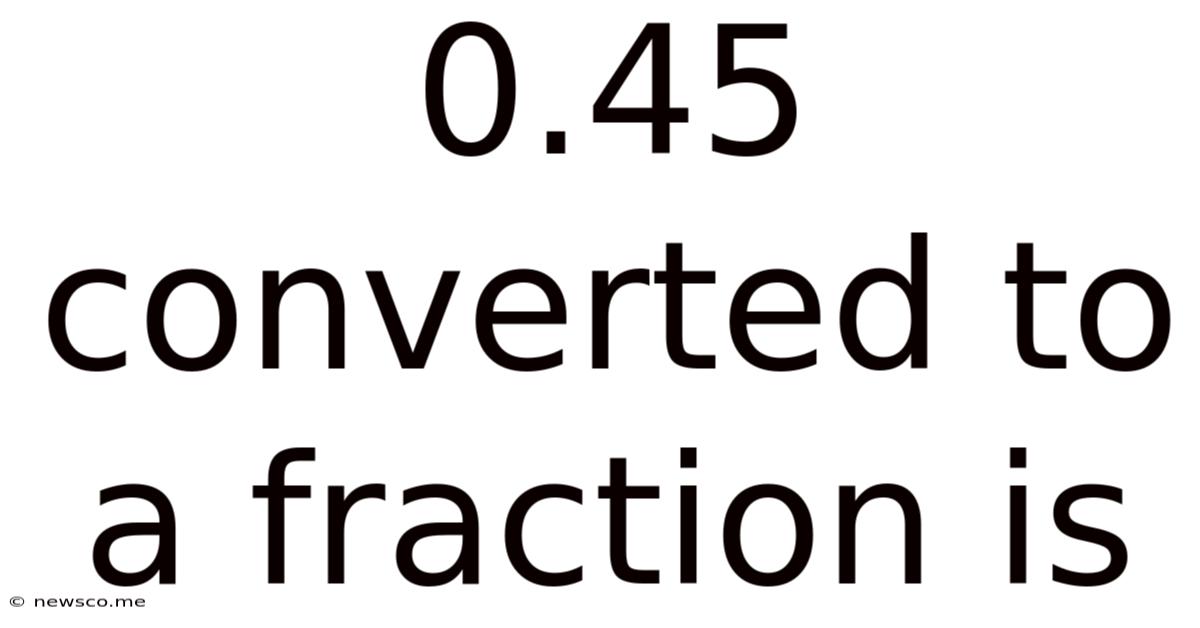0.45 Converted To A Fraction Is
News Co
Mar 17, 2025 · 4 min read

Table of Contents
0.45 Converted to a Fraction: A Comprehensive Guide
Converting decimals to fractions might seem daunting at first, but with a structured approach, it becomes a straightforward process. This comprehensive guide will delve into the conversion of 0.45 to a fraction, explaining the method in detail and exploring related concepts to solidify your understanding. We'll also examine different ways to simplify fractions and tackle more complex decimal-to-fraction conversions.
Understanding Decimal Places
Before we begin, let's refresh our understanding of decimal places. The decimal point separates the whole number part from the fractional part of a number. Each digit to the right of the decimal point represents a power of ten.
- 0.1: One-tenth (1/10)
- 0.01: One-hundredth (1/100)
- 0.001: One-thousandth (1/1000)
In the decimal 0.45, the '4' represents four-tenths (4/10), and the '5' represents five-hundredths (5/100).
Converting 0.45 to a Fraction: Step-by-Step
The core method for converting decimals to fractions involves expressing the decimal as a fraction with a denominator that is a power of 10. Let's break down the conversion of 0.45:
-
Write the decimal as a fraction with a denominator of 1: This is our starting point. We can write 0.45 as 0.45/1.
-
Multiply the numerator and denominator by a power of 10: To eliminate the decimal point, we need to multiply both the numerator and the denominator by 100 (since there are two digits after the decimal point). This gives us:
(0.45 * 100) / (1 * 100) = 45/100
-
Simplify the fraction: Now, we need to simplify the fraction 45/100 to its lowest terms. This means finding the greatest common divisor (GCD) of 45 and 100 and dividing both the numerator and the denominator by it. The GCD of 45 and 100 is 5. Therefore:
45/100 = (45 ÷ 5) / (100 ÷ 5) = 9/20
Therefore, 0.45 converted to a fraction is 9/20.
Understanding Fraction Simplification
Simplifying fractions, also known as reducing fractions to their lowest terms, is crucial for expressing fractions in their most concise form. This involves finding the greatest common divisor (GCD) of the numerator and the denominator and dividing both by it. Let's look at some methods for finding the GCD:
1. Listing Factors:
This method involves listing all the factors of both the numerator and the denominator and identifying the greatest common factor.
For example, let's find the GCD of 45 and 100:
- Factors of 45: 1, 3, 5, 9, 15, 45
- Factors of 100: 1, 2, 4, 5, 10, 20, 25, 50, 100
The greatest common factor is 5.
2. Prime Factorization:
This method involves breaking down both the numerator and the denominator into their prime factors. The GCD is the product of the common prime factors raised to the lowest power.
- Prime factorization of 45: 3² x 5
- Prime factorization of 100: 2² x 5²
The common prime factor is 5, and the lowest power is 5¹. Therefore, the GCD is 5.
3. Euclidean Algorithm:
The Euclidean algorithm is a more efficient method for finding the GCD, particularly for larger numbers. It involves repeatedly applying the division algorithm until the remainder is 0. The last non-zero remainder is the GCD.
Let's apply the Euclidean algorithm to 45 and 100:
- 100 ÷ 45 = 2 with a remainder of 10
- 45 ÷ 10 = 4 with a remainder of 5
- 10 ÷ 5 = 2 with a remainder of 0
The last non-zero remainder is 5, so the GCD is 5.
Converting More Complex Decimals to Fractions
The process we used for 0.45 can be applied to more complex decimals. Let's consider the decimal 0.125:
- Write as a fraction: 0.125/1
- Multiply by 1000 (three decimal places): (0.125 * 1000) / (1 * 1000) = 125/1000
- Simplify: The GCD of 125 and 1000 is 125. Therefore, 125/1000 = (125 ÷ 125) / (1000 ÷ 125) = 1/8
Therefore, 0.125 converted to a fraction is 1/8.
Recurring Decimals and Fractions
Recurring decimals, like 0.333... (0.3 recurring), present a slightly different challenge. Here's how to convert them:
- Let x equal the recurring decimal: x = 0.333...
- Multiply by a power of 10: 10x = 3.333...
- Subtract the original equation: 10x - x = 3.333... - 0.333... This simplifies to 9x = 3
- Solve for x: x = 3/9
- Simplify: x = 1/3
Therefore, 0.3 recurring converted to a fraction is 1/3. This method can be adapted for other recurring decimals, adjusting the power of 10 used to multiply depending on the repeating pattern.
Practical Applications and Conclusion
Understanding decimal-to-fraction conversion is essential in various fields, including:
- Mathematics: Solving equations, simplifying expressions, and performing calculations.
- Science: Measurements, data analysis, and scientific notation.
- Engineering: Precise calculations and design specifications.
- Cooking and Baking: Following recipes accurately.
This comprehensive guide has provided a thorough understanding of converting 0.45 to a fraction (9/20), along with detailed explanations of simplifying fractions and handling more complex decimal conversions, including recurring decimals. By mastering these techniques, you can confidently tackle any decimal-to-fraction conversion and enhance your mathematical skills. Remember to practice regularly to solidify your understanding and improve your efficiency.
Latest Posts
Related Post
Thank you for visiting our website which covers about 0.45 Converted To A Fraction Is . We hope the information provided has been useful to you. Feel free to contact us if you have any questions or need further assistance. See you next time and don't miss to bookmark.